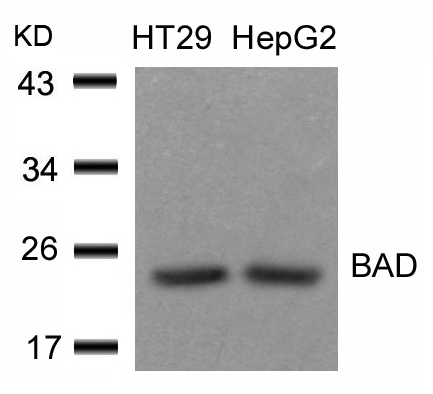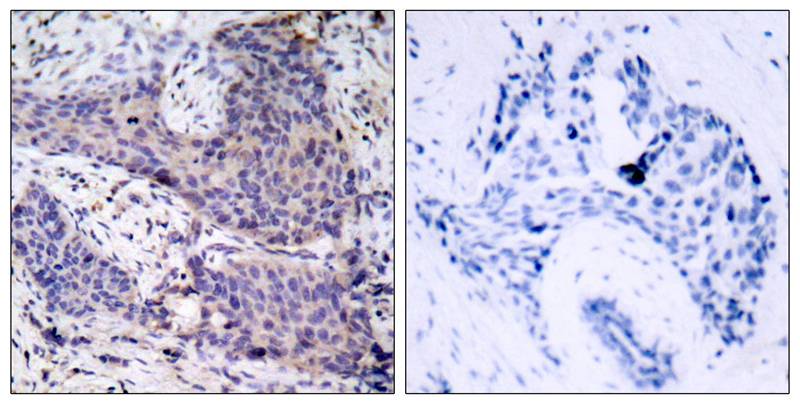

| WB | 咨询技术 | Human,Mouse,Rat |
| IF | 咨询技术 | Human,Mouse,Rat |
| IHC | 1/50-1/100 | Human,Mouse,Rat |
| ICC | 技术咨询 | Human,Mouse,Rat |
| FCM | 咨询技术 | Human,Mouse,Rat |
| Elisa | 咨询技术 | Human,Mouse,Rat |
| Aliases | Bbc2 |
| Entrez GeneID | 12015; |
| WB Predicted band size | 23kDa |
| Host/Isotype | Rabbit IgG |
| Antibody Type | Primary antibody |
| Storage | Store at 4°C short term. Aliquot and store at -20°C long term. Avoid freeze/thaw cycles. |
| Species Reactivity | Human,Mouse,Rat |
| Immunogen | Peptide sequence around aa.134~138 (S-R-S-A-P) derived from Mouse BAD. |
| Formulation | Purified antibody in PBS with 0.05% sodium azide. |
+ +
以下是关于BAD(Ab-136)抗体的3篇参考文献及其摘要内容:
---
1. **文献名称**:*Regulation of Cell Death Protease Caspase-9 by Phosphorylation*
**作者**:Cardone, M.H. et al. (1998)
**摘要**:本研究探讨了BAD蛋白在细胞凋亡中的作用,发现其Ser136位点的磷酸化通过激活AKT通路抑制凋亡。文献中使用BAD (Ab-136)抗体检测磷酸化状态,证实其在生存信号中的关键调控作用。
2. **文献名称**:*Survival Factor-Mediated BAD Phosphorylation Raises the Mitochondrial Threshold for Apoptosis*
**作者**:Datta, S.R. et al. (2002)
**摘要**:研究揭示了生长因子通过激活AKT促使BAD在Ser136位点磷酸化,从而阻止其与Bcl-XL结合并抑制凋亡。Ab-136抗体被用于Western blot分析,验证了磷酸化依赖性调控机制。
3. **文献名称**:*The Role of BAD in Apoptosis and Cancer Chemoresistance*
**作者**:Danial, N.N. et al. (2004)
**摘要**:综述了BAD在癌症耐药性中的作用,重点讨论了其磷酸化修饰(如Ser136)对凋亡通路的影响。研究中引用Ab-136抗体作为检测工具,强调了其在评估肿瘤细胞凋亡敏感性中的应用。
---
**备注**:Ab-136抗体通常指针对BAD蛋白Ser136磷酸化位点的特异性抗体(如Cell Signaling Technology #9295)。上述文献均聚焦于BAD的磷酸化调控机制,实验方法中可能涉及该抗体的应用。如需具体产品引用,建议参考抗体供应商提供的文献列表。
BAD (Ab-136) is a monoclonal antibody developed to target the BAD protein (Bcl-2-associated death promoter), a pro-apoptotic member of the BCL-2 protein family involved in regulating programmed cell death. BAD promotes apoptosis by binding and neutralizing anti-apoptotic proteins like BCL-2 or BCL-XL, thereby activating pro-death effectors such as BAX and BAK. Its activity is tightly regulated by phosphorylation; survival signals (e.g., via growth factors) phosphorylate BAD, causing its dissociation from anti-apoptotic partners and subsequent inactivation. Dysregulation of BAD has been implicated in cancer, neurodegenerative diseases, and other conditions linked to apoptotic imbalance.
The Ab-136 antibody is commonly used in research to detect endogenous BAD protein levels in human, mouse, or rat tissues and cell lines. It is validated for applications like Western blotting, immunohistochemistry, and immunoprecipitation, aiding studies on apoptosis mechanisms, drug responses, or disease models. As a tool, it helps elucidate BAD's role in cell survival pathways, therapeutic resistance, or interactions with signaling kinases (e.g., AKT, MAPK). While not typically used clinically, Ab-136 contributes to preclinical investigations targeting BAD-related pathways for cancer therapy or neuroprotection. Its specificity and reliability make it a key reagent in apoptosis research.
×